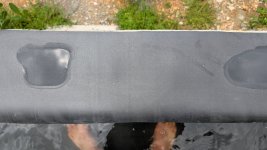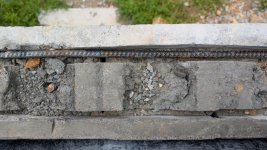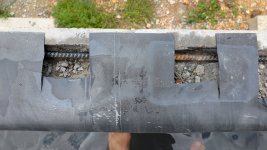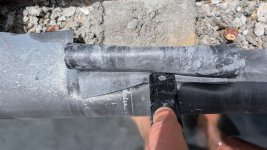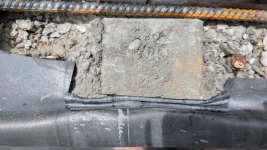Hi Forum!
I've learned so much here from your experiences and I find myself with an opportunity to give back. My pond build is based off of concrete block walls that is lined with EPDM. I want to cap the walls with flagstone. Many people drape the rubber over the walls and then loosely cap them with rock. I wanted a more secure method for both the liner and rock. I believe Waterbug described this method which inspired me and I'm documenting it with detail here. My walls are filled with grout to secure the rebar and add strength. When I filled them, I used a vibrator which lowed the grout level a few inches which is where I wanted the fill. This leaves space for the rubber. Next I used an heavy duty angle grinder with a concrete blade to cut a slot around the perimeter. After installing the rubber, I trimmed it and then bunched it up pressing it down into the groove with a blunt edge. There was some rubber cutting to account for the spaces inside the blocks. After that, I filled the last few inches of block with concrete by hand, securing the liner and leaving plenty of surface to mortar on flagstone that will be stable. The pictures are attached.
One work of caution when securing EPDM rubber to the perimeter of a pond. Make sure not to overstretch the rubber. I filled my pond part way first to press the rubber down in advance. I also added a looseness to the rubber to account for any changes that may occur with settling or temperature fluctuations. I thought I was making a good choice until the sun went away and I watched my loose rubber tighten up after having finished with the concrete. It's not pulling but it has me concerned about how the rubber will respond come winter when it shrinks more. I'll be adding even more slack to the rubber as I continue the project.
Thanks,
Andrew
I've learned so much here from your experiences and I find myself with an opportunity to give back. My pond build is based off of concrete block walls that is lined with EPDM. I want to cap the walls with flagstone. Many people drape the rubber over the walls and then loosely cap them with rock. I wanted a more secure method for both the liner and rock. I believe Waterbug described this method which inspired me and I'm documenting it with detail here. My walls are filled with grout to secure the rebar and add strength. When I filled them, I used a vibrator which lowed the grout level a few inches which is where I wanted the fill. This leaves space for the rubber. Next I used an heavy duty angle grinder with a concrete blade to cut a slot around the perimeter. After installing the rubber, I trimmed it and then bunched it up pressing it down into the groove with a blunt edge. There was some rubber cutting to account for the spaces inside the blocks. After that, I filled the last few inches of block with concrete by hand, securing the liner and leaving plenty of surface to mortar on flagstone that will be stable. The pictures are attached.
One work of caution when securing EPDM rubber to the perimeter of a pond. Make sure not to overstretch the rubber. I filled my pond part way first to press the rubber down in advance. I also added a looseness to the rubber to account for any changes that may occur with settling or temperature fluctuations. I thought I was making a good choice until the sun went away and I watched my loose rubber tighten up after having finished with the concrete. It's not pulling but it has me concerned about how the rubber will respond come winter when it shrinks more. I'll be adding even more slack to the rubber as I continue the project.
Thanks,
Andrew
Attachments
Last edited:


